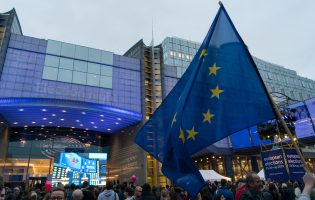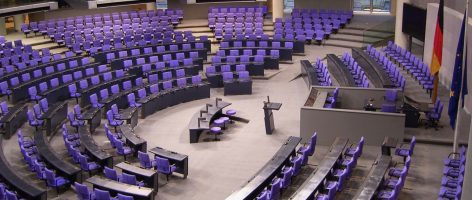Welcoming Cities and the Migration Challenge
AGI held its third annual “Transatlantic Dialogue of the States, Cities, and Communities” on Friday, May 20th, 2016. The conference explored the challenges concerning the integration of immigrants and refugees in Germany and the United States. These challenges were elaborated upon by leaders at the sub-national level who shared their experiences on creating welcoming cities.
Panel I: Welcoming Cities: Responding to New Migrants
Migration has become one of the major issues of our time, and cities play a necessary role in creating a welcoming environment that spreads cultural development and prosperity. Migration is a local issue; communities are ultimately where people interact, participate, and feel a sense of belonging. In the first panel, two mayors from Germany and two city officials from the United States discussed their approach to handling immigration on a local level.
In Germany, the city of Heidenau welcomes many refugees from countries such as Syria and Afghanistan. Over 800 people volunteered in the initial reception phase, and now 100 volunteers teach German and do other things to help ease refugees’ transition into Germany. However, Heidenau has experienced extreme anti-immigrant demonstrations and even violence. The city recognizes that it represents all citizens, and the best way to create a welcoming environment is to organize small groups so that people can talk to one another, learn about one another, and foster a more welcoming environment.
In the city of Pittsburgh, there is a small growth of immigrants. Immigration initiated the early 20th-century economic and population growth that built Pittsburgh into a city of 700,000 and one of America’s great industrial centers. Recently, Pittsburgh has seen considerable population loss and a decline in the number of immigrants to the lowest percentage of new immigration in America. In order to emerge from the industry collapse and become a vibrant and competitive city, Pittsburgh needs new immigrants. Working within the community to hear what a welcoming city should look like is a large aspect of the Welcoming Pittsburgh initiative. Their hope to take in more refugees received backlash from a few groups. However, the initiative still has a strong voice thanks to the mayor being a champion for the community.
The local government is highly under recognized for its monumental role in immigration and has done a lot more for St. Louis than people realize. In St. Louis, the local government is focused on spurring economic growth through immigration. They have a low number of immigrants, but want to focus on increasing that number for cultural progression and prosperity through the “Mosaic Project.” Attracting more immigrants is necessary to stay vibrant as a city. The government has also developed a welcoming ambassadors program in which the ambassadors not only tell new migrants about life in St. Louis, but they learn about the immigrants’ culture as well.
The city of Moritzburg saw a change in integration through “Vielfalt Moritzburg”—an initiative put in place to get the citizens to help include the refugees in society. Full time social care, group coaching, organization teams, language activities, and even offering the welcome pamphlet in various languages gave Moritzburg a start to becoming a welcoming city. Much like St. Louis, the people of Moritzburg are making an effort to learn more about the new migrants’ culture, which includes Arabic classes for Moritzburg’s citizens.
There have been bumps in the road for each of these cities. Some people are still against bringing in more refugees and immigrants. They have misconceptions that immigration will increase crime or take away jobs. This is why reaching out to younger innovative individuals and focusing on visibility and community outreach is crucial. Connecting people with storytelling is also a worthwhile approach to increasing morale. Although each city faces difficulties and enacting change is a lengthy process, they continue to strive towards their goals and do not let the immigration issue go unnoticed. Each city sees new immigrants as a way to reinvigorate the culture and economy of their communities; they want to invest in all people living in their communities so that those people will then reinvest in their communities.
Questions during the Q&A focused on the state interactions with the locals, community outreach, and advice for being a welcoming city. An on-the-ground approach is significant in finding a common ground between the state and local community. Events such as the Festival of Nations help bring cultures together. Money is the foundation to achieving the goals these cities have. This is why partnering with the state and federal government is necessary for funding. Spreading awareness to get other organizations involved can also provide financial aid. In addition, churches have played a vital role in engagement. Officials should make clear that the refugees are welcome, clearly and publicly take a policy position, and broaden exposure to newcomers in those communities that aspire to be more welcoming.
Panel II: Integration Policy and Practice
How immigration happens at the local level and how cities address short and long term immigration needs to be considered in order to understand the bigger picture. In Germany, there has been a profound policy shift in the last twenty to thirty years. Until the 1990s, immigrants were viewed as temporary guests, so there was no sense of urgency in integrating them into society. They could come and continue to live the way they did—creating a “multikulti” society.
Integration is now center stage. It is easier for migrants to come and have their education abroad recognized and becoming a German citizen has also been simplified. There are still many obstacles in the integration process. People often question if migrants take advantage of the new services given to them. This can cause resentment and violence from citizens. Keeping the attitudes of the public positive through awareness programs is imperative. Also, some immigrants disagree with having to abide by a country’s social norms.
In the United States, federal funding allows locals to carry out the resettlement and integration process. Approximately 85,000 refugees were resettled this year in the United States. Where people live does shape their integration experience. Los Angeles is a gateway for immigrants. The city has specific policies and strategies to help immigrants. By catering to refugees specific needs, health, education, and faith communities were put in place. In the school setting, policies to help with transitional aspects are needed. There are many issues with young people because they may feel neglected in their own home or community especially if they are unaccompanied. Making friends can also be challenging because of the language barrier. This makes feeling welcome in school more difficult. More resources need to be available for immigrants especially at a young age so they will be able to feel welcome as soon as they enter a new country. Different foundations, including Our Children’s Relief Fund, exist to combat these problems. There are many parallels to what is happening in Germany as well. For example, the comparable numbers of unaccompanied minors in the United States and Germany may make it possitble learn more from each other’s experiences.
Goals were discussed in terms of what will help improve the economy through integration. Mentoring programs will ease the process of an immigrant finding a job. Germany would like to get people into a skilled job so they can move up on the career ladder. The United States would rather see an immigrant get a job as fast as possible. The main goal is to help immigrants find work so that they can help boost the economy in addition to making the community more culturally vibrant. Migrating to a new country also means accepting the social contract. These immigrants and refugees must face these differences and accept the policies that are being put in place to make the process more comfortable. Current residents must also understand the benefits of immigration for the wellbeing of the city and keep an optimistic outlook. A welcoming approach is crucial to a successful integration process.
Please contact Ms. Elizabeth Caruth with any questions at ecaruth@aicgs.org.
Location
The Urban Institute
2100 M Street NW 5th Floor Washington, DC 20037 United States







